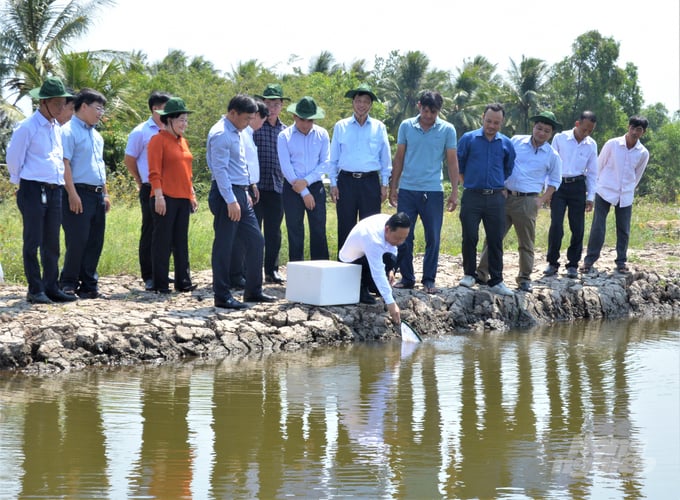May 21, 2025 | 05:02 GMT +7
May 21, 2025 | 05:02 GMT +7
Hotline: 0913.378.918
May 21, 2025 | 05:02 GMT +7
Hotline: 0913.378.918
Kien Giang is a coastal province, having strengths in mariculture specifically brackish shrimp farming. Through the review, the province currently has more than 42,900 establishments and households engaged in various types of production such as intensive shrimp farming, semi-intensive shrimp farming, shrimp-rice model, and improved extensive shrimp farming. With a total of nearly 34,700 establishments, all businesses, cooperatives and households are required to register for mariculture establishment codes.

Kien Giang is a coastal province, having strengths in mariculture. Photo: Trung Chanh.
The work of issuing identification codes for brackish water shrimp farms in Kien Giang has been accelerated. According to information from the Aquaculture Division, Kien Giang Sub-Department of Fisheries, in just one month, the unit has issued nearly 2,100 certificates of identification code for the farming area. Accumulated to the end of January 2023, the province has issued nearly 27,400 certificates, reaching nearly 79% of the plan.

Kien Giang Sub-Department of Fisheries has trained farmers and given guidance in the implementation of granting identification codes for brackish water shrimp farming establishments. Photo: Trung Chanh.
According to Mr. Kim Hoang Thanh, Director of Kien Giang Sub-Department of Fisheries, the issuance of identification codes for mariculture establishments, including brackish water shrimp farms, is a mandatory requirement under the Law on Fisheries 2017. This contributes to the work of product traceability, meeting the requirements of shrimp importing countries, and improving the effectiveness and efficiency of state management, towards the goal of scientific and modern management of the industry.
Local agencies are guiding the people of Kien Giang to carry out the procedures. Farmers receive support to complete the dossier for granting brackish water shrimp farming establishment codes and send it to the provincial Public Administration Service Center. The province’s agricultural sector has also issued many official documents and plans to speed up the implementation, remove difficulties and obstacles, directly guide communes and towns in the work of granting identification codes for brackish water shrimp farming establishments in the management area.
The issuance of identification codes for brackish water shrimp farming establishments in Kien Giang province receives high consensus among the people, which is thanks to keen attention and drastic actions from the functional sector and local authorities. The number of dossiers for granting identification codes for brackish water shrimp farming establishments has increased significantly.
Mr. Le Van Khanh, Head of the Office of Agriculture and Rural Development of An Minh district, said that the granting of codes for brackish water shrimp farming establishments in the district has recorded good results. So far, more than 99% of households have been considered eligible. The Office of Agriculture and Rural Development coordinates with communes and towns to review and compile a list of brackish shrimp farming households, then provides guidance on the declaration of registration dossiers.
According to statistics, the whole district has nearly 16,000 households that need identification codes for brackish water shrimp farming. The number of households eligible for identification codes for brackish water shrimp farming is nearly 8,460 households.

The organization of issuing codes for brackish water shrimp farming establishments in An Minh district has been well-implemented. Up to now, over 99% of the establishments have been granted codes. Photo: Trung Chanh.
As a farmer household that has converted to the shrimp-rice model for more than twenty years, Mr. Le Thanh Tuan in Thuan Hoa commune (An Minh district, Kien Giang) said, “This is a mandatory regulation of the Law on Fisheries 2017, so the people must follow. The issuance of farming area codes also contributes to improving the value of farmed shrimp when having a clear origin and meet the traceability requirements of the import market. I see this as something that brings many practical benefits to the people”.
In a similar manner, the work of issuing identification codes for aquaculture facilities is also being accelerated in Vinh Thuan district. Mr. Nguyen Thanh Binh, Deputy Head of the Office of Agriculture and Rural Development of Vinh Thuan district, said that the total number of shrimp farming households initially counted in the district exceeded 10,100 households. But after careful review, there are nearly 10,000 households left.
The reason for this was due to the initial statistics of production households. After comparing with the certificate of land use right, there was actually only one paper. It was because the parents divided the land among their children but did not separate the plot.
According to Mr. Binh, up to now, Vinh Thuan district has completed 100% of the dossiers eligible for the identification codes of brackish water shrimp farming establishments and submitted it to the provincial Sub-Department of Fisheries, with nearly 8,100 dossiers in total.
Translated by Samuel Pham

(VAN) Japan's grant aid project contributes to capacity building, promoting organic agricultural production, and fostering sustainable community development in Dong Thap province.

(VAN) For years, the CRISPR-Cas9 genome technology has been reshaping genetic engineering, a precision tool to transform everything from agriculture to medicine.

(VAN) Vietnam aims to become a 'leader' in the region in the capacity and managing effectively soil health and crop nutrition.
![Reducing emissions from rice fields: [Part 1] Farming clean rice together](https://t.ex-cdn.com/nongnghiepmoitruong.vn/608w/files/news/2025/05/05/z6509661417740_a647202949c539012a959e841c03e1d3-nongnghiep-143611.jpg)
(VAN) Growing clean rice helps reduce environmental pollution while increasing income, allowing farmers to feel secure in production and remain committed to their fields for the long term.
/2025/05/19/5136-1-144800_230.jpg)
(VAN) The Nghe An Provincial People's Committee has just approved the list of beneficiaries eligible for revenue from the Emission Reductions Payment Agreement (ERPA) in the North Central region for the year 2025.

(VAN) 14 out of 35 domesticated elephants in Dak Lak province have had their living conditions improved, with 11 of them currently participating in the non-riding elephant tourism model.

(VAN) Muong Nhe Nature Reserve hopes that being upgraded to a national park will lay the foundation for forest protection efforts to be carried out in a systematic, modern, and sustainable manner.